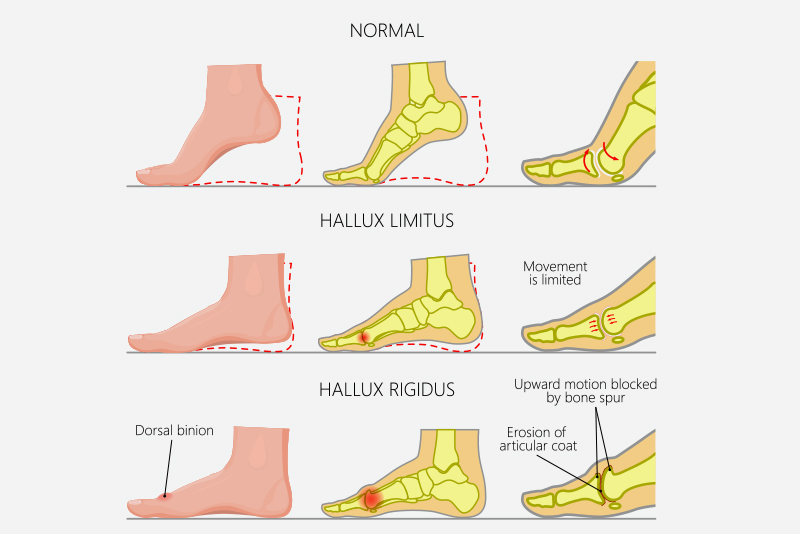If you’re feeling stiffness in your big toe, you may have Hallux Limitus or Hallux Rigidus. Hallux Limitus is stiffness in the big toe which we described in our article here. As the condition progresses, bone spurs and arthritis can develop in the toe and cause it to become rigid and inflamed, with very limited movement. This condition is called Hallux Rigidus, or osteoarthritis of the big toe.
What causes Hallux Rigidus?
Arthritis of the big toe can occur due to a variety of reasons and is more common in women than men. It mostly affects people over the age of 50 years, although the symptoms can start as early as 30 if there has been injury or trauma to the big toe.
Some of the known causes of arthritis in the big toe are:
- Abnormal function of the foot due to structural problems which may cause excessive pressure and increase wear and tear on the joint.
- Flat arches or pronation which also places excessive strain on the big toe joint.
- Genetics – you may have inherited a foot shape that is prone to developing this condition. Preventive care will help to minimise the impact of hereditary factors.
- Injury to the toe which causes trauma to the joint.
- Deterioration of the joint which can happen with age.
What are the symptoms of Hallux Rigidus?
The big toe can become very stiff and sore especially when getting up from a squatting position, walking or any activity that requires the big toe to bend.
The pain is usually at the top of the big toe joint which gets worse with time the longer you leave it unattended. A bony lump can also develop. This is different to a bunion which is on the inside of the foot. An arthritic bump sits on top of the big toe joint.
The sooner you receive treatment, the better off you will be as you get older. The health of your feet is important to help you have a positive ageing experience. To live well and healthy as you age, maintaining strength, flexibility and mobility in your feet is essential. Make an appointment with one of our podiatrist for a foot assessment and diagnosis.
Treatment of Hallux Rigidus
At Sanders Podiatry Clinics, we use a number of techniques to diagnose the condition of your toe, and then to choose the best form of treatment depending on your lifestyle, foot mechanics and alignment. We’ll assess your gait, and whether you have any other pain in your ankles, knees or lower back. Common treatment of Hallux Rigidus includes the following:
- Changing your footwear so that there is no pressure on the big toe joint which alleviates further inflammation
- Manual techniques to improve the range of movement
- Orthotics to reduce the pressure on the toe joint
- Strapping or taping to minimise movement and reduce pain
- Your doctor may also recommend anti-inflammatories or medications to help relieve pain and inflammation.
Make an appointment with our family-friendly podiatry team
There are ways to relieve the tenderness in your toes caused by arthritis and to prevent further deterioration. Call us and make an appointment so that we can assess your feet and other potential contributing factors which may be causing more pain. With some manual therapy, footwear advice and other supportive measures, we’ll help to reduce pain and swelling and help you get back on your feet with less discomfort.
Our podiatry clinics are in three locations around Adelaide.
Sander Podiatry Adelaide – 08 8379 1456 (Greenhill Podiatry)
